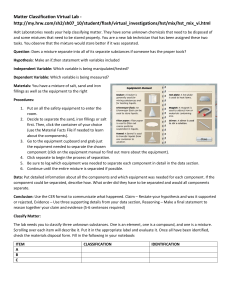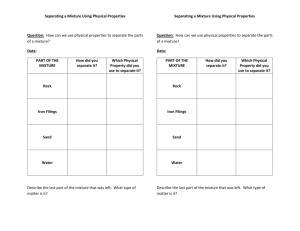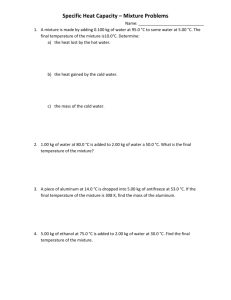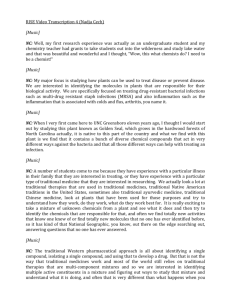Lab Mixture Separation
advertisement
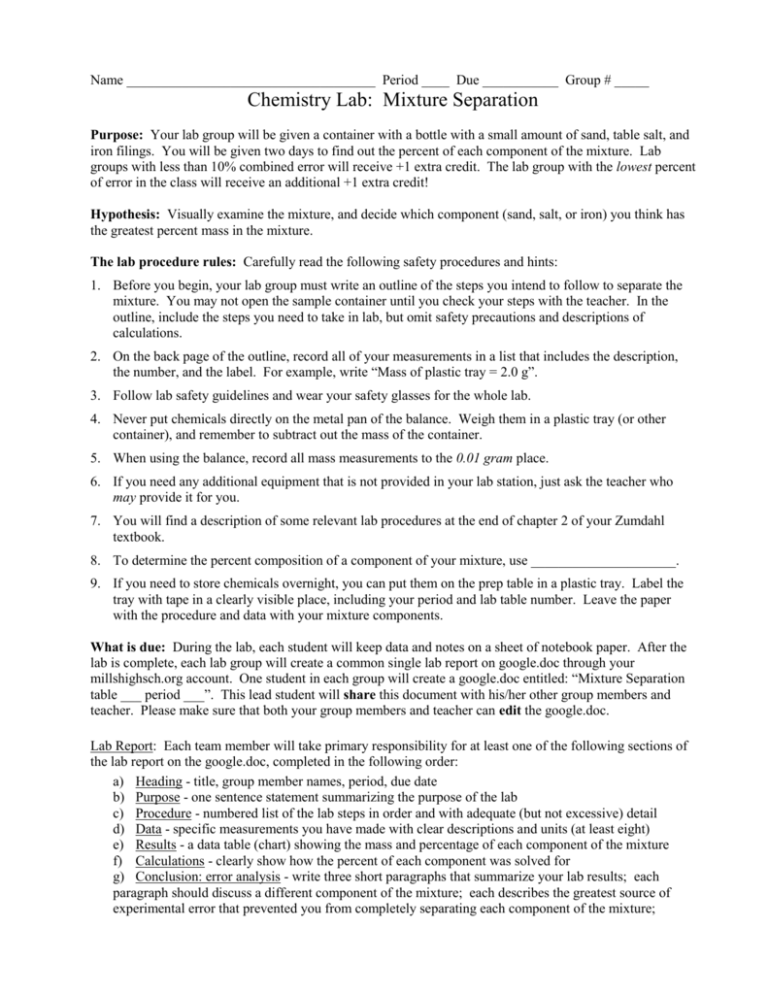
Name ____________________________________ Period ____ Due ___________ Group # _____ Chemistry Lab: Mixture Separation Purpose: Your lab group will be given a container with a bottle with a small amount of sand, table salt, and iron filings. You will be given two days to find out the percent of each component of the mixture. Lab groups with less than 10% combined error will receive +1 extra credit. The lab group with the lowest percent of error in the class will receive an additional +1 extra credit! Hypothesis: Visually examine the mixture, and decide which component (sand, salt, or iron) you think has the greatest percent mass in the mixture. The lab procedure rules: Carefully read the following safety procedures and hints: 1. Before you begin, your lab group must write an outline of the steps you intend to follow to separate the mixture. You may not open the sample container until you check your steps with the teacher. In the outline, include the steps you need to take in lab, but omit safety precautions and descriptions of calculations. 2. On the back page of the outline, record all of your measurements in a list that includes the description, the number, and the label. For example, write “Mass of plastic tray = 2.0 g”. 3. Follow lab safety guidelines and wear your safety glasses for the whole lab. 4. Never put chemicals directly on the metal pan of the balance. Weigh them in a plastic tray (or other container), and remember to subtract out the mass of the container. 5. When using the balance, record all mass measurements to the 0.01 gram place. 6. If you need any additional equipment that is not provided in your lab station, just ask the teacher who may provide it for you. 7. You will find a description of some relevant lab procedures at the end of chapter 2 of your Zumdahl textbook. 8. To determine the percent composition of a component of your mixture, use _____________________. 9. If you need to store chemicals overnight, you can put them on the prep table in a plastic tray. Label the tray with tape in a clearly visible place, including your period and lab table number. Leave the paper with the procedure and data with your mixture components. What is due: During the lab, each student will keep data and notes on a sheet of notebook paper. After the lab is complete, each lab group will create a common single lab report on google.doc through your millshighsch.org account. One student in each group will create a google.doc entitled: “Mixture Separation table ___ period ___”. This lead student will share this document with his/her other group members and teacher. Please make sure that both your group members and teacher can edit the google.doc. Lab Report: Each team member will take primary responsibility for at least one of the following sections of the lab report on the google.doc, completed in the following order: a) Heading - title, group member names, period, due date b) Purpose - one sentence statement summarizing the purpose of the lab c) Procedure - numbered list of the lab steps in order and with adequate (but not excessive) detail d) Data - specific measurements you have made with clear descriptions and units (at least eight) e) Results - a data table (chart) showing the mass and percentage of each component of the mixture f) Calculations - clearly show how the percent of each component was solved for g) Conclusion: error analysis - write three short paragraphs that summarize your lab results; each paragraph should discuss a different component of the mixture; each describes the greatest source of experimental error that prevented you from completely separating each component of the mixture; clearly state how the error affected your results (i.e. would the error lead to a higher or lower percent composition of that component?) h) Conclusion: summary - write a CER (Claim, Evidence, Reasoning) paragraph that compares your hypothesis with your lab results to determine which component had the greatest percent composition. (your teacher will discuss CER writing with you before you do this part) i) Extension question #1 - imagine that your salt, sand, and iron mixture also contained sawdust. Suggest either a way that you could isolate the sawdust from the rest of the mixture to determine its mass. j) Extension question #2 - imagine that your salt, sand, and iron mixture also contained sugar. Explain why it is difficult to isolate and determine the mass of sugar in the mixture. After each section is complete, the other students must write “comments” on the google.doc with suggestions, clarifying questions, or updates on each of the other sections. The author of that section will then take the comments into consideration and update his/her work. Do not “resolve” the comments (or your comments will disappear). The teacher will check both the “revision history” and the “comments” to determine who is actively participating in writing the lab report.


